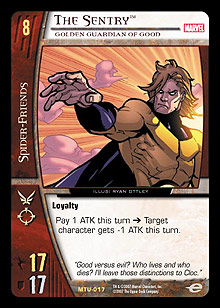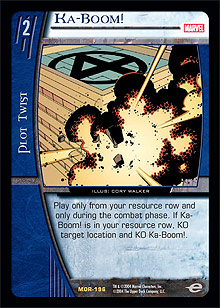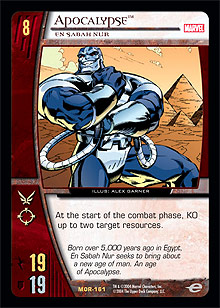
|
The Sentry™
Card# MTU-017


While his stats aren’t much bigger than those of the average 7-drop, Sentry’s “Pay ATK” power can drastically hinder an opponent’s attacking options in the late game.
Click here for more
|
|
|

|
|
|

 |
 |
|
|
| |
|
Welcome to the second part in the "Adjusting to Vs." series. The objective of this series is to accelerate the speed at which players adapt to the unique mechanics of the Vs. System. After looking at the double-draw mechanic in the first instalment, today is going to deal with one of the most game-defining factors of any TCG—resource management.
 Ok, so by this point you probably know the basics—you can set a card in your resource row during the resource step of the build phase, one card per turn. During the recruit step, each card in your resource row provides one point towards paying recruit costs for characters and equipment, and during the rest of the turn, this same number acts as your threshold for activating cards that have threshold costs (locations and plot twists). So, if you want to continue growing in both offensive and defensive terms, you need to drop a resource each turn. On top of that, it seems good to make sure that each resource you set is a plot twist or location; if you're setting characters or equipment cards, you generally lose access to the card you're setting for the duration of the game, costing yourself the utility of that card. In addition, if you set a plot twist and then use it, you're effectively using it for free—you were already going to lose the one card of hand advantage by setting a resource anyways. However, if you set a character and then play the same plot twist from your hand, you've in effect given up two cards of hand advantage to accomplish the same thing. These are general rules, however, and there are some exceptions. Ok, so by this point you probably know the basics—you can set a card in your resource row during the resource step of the build phase, one card per turn. During the recruit step, each card in your resource row provides one point towards paying recruit costs for characters and equipment, and during the rest of the turn, this same number acts as your threshold for activating cards that have threshold costs (locations and plot twists). So, if you want to continue growing in both offensive and defensive terms, you need to drop a resource each turn. On top of that, it seems good to make sure that each resource you set is a plot twist or location; if you're setting characters or equipment cards, you generally lose access to the card you're setting for the duration of the game, costing yourself the utility of that card. In addition, if you set a plot twist and then use it, you're effectively using it for free—you were already going to lose the one card of hand advantage by setting a resource anyways. However, if you set a character and then play the same plot twist from your hand, you've in effect given up two cards of hand advantage to accomplish the same thing. These are general rules, however, and there are some exceptions.
The above paragraph gives the basic details of resource management, but odds are that if you've been playing Marvel for a week or two, you already knew what I just said. If you haven't played Marvel yet, or hadn't had time to figure those things out, well, no worries—welcome to the party, you're officially caught up.
However, this is Vs., which means the basics are only the beginning. There's a lot more to resource row management in this game than understanding that a set location or plot twist is a good thing. There are many different cards that interact with the resource row in interesting ways. These interactions vary and can be helpful or detrimental to your strategy.
Resource Acceleration
First up, there are cards that let you do more with your current resources than would normally be possible. These are positive cards that accelerate your development, allowing you to recruit characters and equipment at lower costs than normal, or activate plot twists and locations that you normally wouldn't have a large enough threshold to use.
Alicia Masters, Blind Sculptress has an activated effect that lets you recruit any Thing or Human Torch card for one point less for a single turn. The effect is stackable, so if you use an effect that readies Alicia again (such as the plot twist Cosmic Radiation), you can get an even bigger discount on some pretty great characters. Franklin Richards, Child Prodigy has the same effect, only it is instead applied to mommy and daddy—Mr. Fantastic and Invisible Woman.
 Speaking of Mr. Fantastic, two of his versions (Mr. Fantastic, Stretch and Mr. Fantastic, Scientific Genius), reduce your equipment recruit costs by 1 and 2 respectively. Between these two cards, Alicia, and Franklin, one of the team characteristics of the Fantastic Four starts to become evident. Just like in the comic books, the team uses intelligence and planning to increase the potential of the heavy-hitting abilities they have. The result? A team that can routinely circumvent the intended curve of development in the game, allowing players to go past the normal potential of their resource rows. Speaking of Mr. Fantastic, two of his versions (Mr. Fantastic, Stretch and Mr. Fantastic, Scientific Genius), reduce your equipment recruit costs by 1 and 2 respectively. Between these two cards, Alicia, and Franklin, one of the team characteristics of the Fantastic Four starts to become evident. Just like in the comic books, the team uses intelligence and planning to increase the potential of the heavy-hitting abilities they have. The result? A team that can routinely circumvent the intended curve of development in the game, allowing players to go past the normal potential of their resource rows.
Two other notable cards that allow you to get ahead of the curve are Beast, Dr. Henry McCoy and Latveria. Both of these cards reduce the threshold cost of plot twists by one.
Finally, Master Mold, Sentinel Supreme allows you to put an army Sentinel character from your hand into play during your recruit step. This allows you to basically spend up to four points per turn that you don't actually have. Very impressive.
Resource Replacement
Next up, another option for interacting with the resource row (yours or your opponents', in this case), is replacement, or exchanging one card in the resource row for another.
Jean Grey, Marvel Girl is an example of a card that replaces resource row cards. She allows you to KO one of your resources and replace it with the card on the top of your deck. The advantages to this are numerous. If the card you're looking to replace is one you no longer need, for instance a location you no longer desire in play or a non-ongoing plot twist that you have already used, the replacement could allow you to set a new location or plot twist in its place (the gamble being that a prime character or equipment card might land there instead). If the card you're replacing is a character card, getting it out of the resource row and into the KOd pile could bring it one step closer to being replaced into the deck or hand. It's an effect that's worth more than a cursory glance.
Avalanche, Dominic Petros and Relocation both provide a more offense-minded replacement, both targeting locations. Avalanche is like a Jean Grey for your opponent's location cards, KOing them and replacing them with (hopefully useless) cards from the deck. This is always going to be disruptive, but is extra-nice against location-dependant combos. Nothing like blowing up the Negative Zone just in time to make Annihilus reeeeeally angry. Relocation can be even more devious. It doesn't just replace the location targeted with a card from the opponent's deck—it takes the targeted location and sticks the opponent with the now-dead Relocation.
Resource Destruction
 Of course, if replacement is good, then plain old destruction is going to be even better. Apocalypse, En Sabah Nur KOs two of your opponent's resources, and Dark Phoenix, Cosmic Entity provides a total lock, destroying all resources in play, period. Both are exceedingly expensive to use though, so for some decks, less powerful resource destruction is often the better way to go. Ka-Boom! and Foiled are both plot twists that KO an opponent's resource at the cost of KOing themselves from the resource row. Ka-Boom! takes out a location, and Foiled takes out an ongoing plot twist. This might not seem particularly useful at first glance, but in reality they're both highly useful, allowing a player to limit an opponent's options. If you start Ka-Boom!ing and Foiling on turn 3 or 4, and build your deck to have very few (if any) characters with a recruit cost higher than 4, your opponent (who presumably has a variety of recruit costs in his or her deck) is going to get shafted and lose control of the game as he or she quickly runs out of playable characters. I suspect that this kind of offensive resource management is going to become very popular, and I'll get into why in the next instalment of this series when we take an in-depth look at the recruitment cost curve. Of course, if replacement is good, then plain old destruction is going to be even better. Apocalypse, En Sabah Nur KOs two of your opponent's resources, and Dark Phoenix, Cosmic Entity provides a total lock, destroying all resources in play, period. Both are exceedingly expensive to use though, so for some decks, less powerful resource destruction is often the better way to go. Ka-Boom! and Foiled are both plot twists that KO an opponent's resource at the cost of KOing themselves from the resource row. Ka-Boom! takes out a location, and Foiled takes out an ongoing plot twist. This might not seem particularly useful at first glance, but in reality they're both highly useful, allowing a player to limit an opponent's options. If you start Ka-Boom!ing and Foiling on turn 3 or 4, and build your deck to have very few (if any) characters with a recruit cost higher than 4, your opponent (who presumably has a variety of recruit costs in his or her deck) is going to get shafted and lose control of the game as he or she quickly runs out of playable characters. I suspect that this kind of offensive resource management is going to become very popular, and I'll get into why in the next instalment of this series when we take an in-depth look at the recruitment cost curve.
Payment
Resources can also be used as payment for an effect. Though the first example of this that might come to mind is a "KO X Resources to [do whatever]" type card, such as The Power Cosmic, which KOs all of your resources when you activate it, there are subtler implementations of the same type of idea. For instance, Underground Sentinel Base allows you to reveal a face-down army Sentinel character card in your resource row and move it face up to your front row or support row. Though it doesn't KO a resource, you're still losing that card from the resource row without being permitted to replace it. It can often be a difficult decision from a resource management point of view—not only are you giving up an extra card of hand advantage by setting a character as a resource (as was detailed earlier in this article), you're also depriving yourself of a turn's worth of development down the road. Not a problem if the game ends this turn, which it very well might, considering the advantage Underground Sentinel Base can give you. But if the game is going to continue beyond the current turn, it might not be worth activating the Base.
Positional Management/Restraint
There are a couple cards in Origins that benefit outside-the-box thinking—cards that reward positional management (whether your resources are face up or face down) and cards that reward you for not playing resources altogether. Hulk, New Fantastic Four gets an ATK bonus for every face-down resource you control, while Volcana, Marsha Rosenberg has a nasty activated effect that deals endurance loss to target player equal to the number of face-up resources her controller has in his or her resource row.
 Hulk and Volcana are interesting, but the real eyebrow-raiser of the bunch is the ongoing plot twist The New Brotherhood. While this plot twist is face-up in the resource row, all Brotherhood characters you control get +2 ATK. In some situations, this card can be so good that it gives a player a reason to not continue developing beyond four total resources. This is a viable strategy if done correctly, but the mathematical and strategic reasoning as to why this is lies in the recruitment cost curve, so we'll deal with that in the next column. Hulk and Volcana are interesting, but the real eyebrow-raiser of the bunch is the ongoing plot twist The New Brotherhood. While this plot twist is face-up in the resource row, all Brotherhood characters you control get +2 ATK. In some situations, this card can be so good that it gives a player a reason to not continue developing beyond four total resources. This is a viable strategy if done correctly, but the mathematical and strategic reasoning as to why this is lies in the recruitment cost curve, so we'll deal with that in the next column.
Resource acceleration, replacement, destruction, payment, and position/restraint are the five advanced resource row issues a player can face and work to their advantage in Marvel Origins. No doubt, in later sets, these management issues will be joined by many others, but for now, these five elements are your main concern. Now that you know them, you can recognize them and use them to your advantage, and hopefully you're one step closer to adapting to Vs.
Please send any questions or comments about this article to Jason@metagame.com. Thanks for reading!
|
| |
| Top of Page |
|
 |
|
|
 |